One of the gifts that comes with the zoo side of my job is making the acquaintance of all sorts of exotic animals. Much of what I’ve learned from being on more intimate terms with these animals has surprised me. A good example would be how I learned to speak to tigers.
Crouching Tiger, Hidden Language
 Of all predators at the apex of their food chain, the most fearsome would probably be the great white shark, the polar bear and the tiger. I had the tiger’s ferocity intimately demonstrated to me while navigating a narrow caged passageway years ago at the Racine Zoo with Tom Torhorst, the director. The passage was only wide enough for one person, so I was following him as he explained that we were passing over the night holding cage of their female white tiger, Coma.
Of all predators at the apex of their food chain, the most fearsome would probably be the great white shark, the polar bear and the tiger. I had the tiger’s ferocity intimately demonstrated to me while navigating a narrow caged passageway years ago at the Racine Zoo with Tom Torhorst, the director. The passage was only wide enough for one person, so I was following him as he explained that we were passing over the night holding cage of their female white tiger, Coma.
In his role as head veterinarian, he had done a root canal operation on one of Coma’s back teeth. For safety reasons they did not fully anesthetize her, so she was aware that it was Dr. Tom who caused her so much pain, and she demonstrated her displeasure with him at every opportunity thereafter.
Just as he finished speaking, a huge, red, slathering mouth lined with ivory colored spikes as long as my fingers appeared about 6 inches from the left side of my face. Fortunately it was on the other side of the steel mesh. It was accompanied by a blast of rancid breath that blew my hair back and a roar that not only left my ears ringing but sent a shock wave through my torso like the concussion from an artillery shell. On either side of the face were huge mittens with curving claws as long as the teeth, piercing the steel mesh from whence the tiger hung.
Dr. Tom chuckled and told me not to be alarmed, that Coma’s demonstration was aimed at him, not me. He was kind enough not to comment on the shaking I was struggling to control and hopefully didn’t notice when I checked the front of my jeans expecting to find a large wet spot.
On a subsequent trip to do more work in the Zoo’s main building, I was painting in a bird exhibit adjacent to Coma’s. The staff had told me that when they let her back into her public exhibit space, Coma didn’t seem particularly appreciative of the murals I’d painted for her. Her reaction was to back up to a section of the Indian landscape scene and pee on it.
From the bird exhibit, all that stood between me and Coma was about 20 feet of air and a section of harp wire across the front of both exhibits. She could smell and hear everything I was doing.
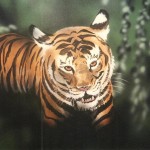 After a few days of seeming indifference she began rubbing her head along the harp wire, making a faint purring sound, not continuously like a house cat but in short pulses. I did my best to imitate it, and she stopped pacing, looking me in the eyes.
After a few days of seeming indifference she began rubbing her head along the harp wire, making a faint purring sound, not continuously like a house cat but in short pulses. I did my best to imitate it, and she stopped pacing, looking me in the eyes.
While cleaning my equipment downstairs I asked a keeper about this behavior and was told that she had apparently decided she liked me. So for the next few days I honed my purring skills, and we had several long, if monotonous, conversations. I’ve since used my discovery to elicit a mild startle response from other tigers and an expression that might translate as, “Wha’d you say?”
Several month after completing the murals, I brought my young daughter to see them. I showed her how to address the beautiful white tiger. She tried it and to her utter delight, the tiger responded in kind. “Dad, I can speak tiger!” she chortled.
We continued along the line of exhibits and came to an elderly male lion standing on a rock watching the humans parade past him. He seemed to be in a grumpy mood; maybe his lunch was late.
I had picked up my daughter and was holding her on one arm when she decided to try speaking tiger to the lion. He looked at her, lowered his massive head, extended his neck and let loose with a window-rattling roar! My daughter leaped from her comfortable position on my arm and perched herself atop my head shaking like a turban made of Jello. When she was able to calm herself, she declared her intention to learn to speak lion as well.
Etiquette
A couple of years ago I picked up more tiger etiquette from a Midwestern zoo director who had raised a half-dozen tigers. He told me that tigers don’t like humans standing tall over them, so he got down on all fours to approach their cage, demonstrating the short purring sound. The three adolescent tigers inside sauntered up to the bars in front with the same roundabout swagger I see in my own house cat. And like my house cat these tigers put their heads down and butted up against the bars. The zoo director butted his head up against theirs. This is apparently a standard greeting throughout the cat world.
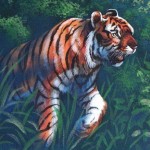 He then stuck his hand through the bars to pet them but he did so with a fist. He explained that nipping each other is affectionate behavior between tigers and their tough hides can handle it. If they affectionately nip a human hand it can mean the loss of a few fingers. He showed me the puncture wounds on one hand from a tiger kitten who was startled while being bottle-fed. As beautiful and friendly as tigers can seem, it’s wisest to remember that they are unpredictable, powerful, lightning-fast killers.
He then stuck his hand through the bars to pet them but he did so with a fist. He explained that nipping each other is affectionate behavior between tigers and their tough hides can handle it. If they affectionately nip a human hand it can mean the loss of a few fingers. He showed me the puncture wounds on one hand from a tiger kitten who was startled while being bottle-fed. As beautiful and friendly as tigers can seem, it’s wisest to remember that they are unpredictable, powerful, lightning-fast killers.
I haven’t had a lot of personal rapport with lions. While they are cute as cubs and make very good friends if raised by people, they seem a bit dull compared to tigers.
Cats
Here are a few additional discoveries about cats. African leopards are surprisingly small and lightweight. I know of one incident early in the last century in which a naturalist was able to kill a leopard with his bare hands. Of course in the photo, his hands are covered in bandages.
The elegant but very bashful snow leopard, with her subtle coloring and impossibly long, bottle-brush tail, is smaller still, halfway between what you might expect and a house cat.
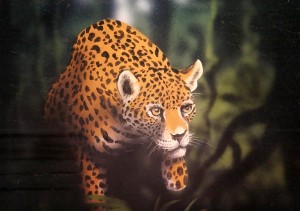 Jaguars, a New World cat, are just the opposite: aggressive and powerful. They have relatively short legs, thick bodies and large heads to support their huge jaw muscles. If you were strolling through the Amazon jungle, you would probably hear their clumsy crunching through the leaf litter as they stalked you on a parallel track, sometimes with one jaguar on either side of the trail. But you’d never see them until nightfall, when your campfire would light up their eyes in the blackness. They are not particularly afraid of fire. Your safest place is in a hammock high up in a tree, slung between branches too small to support the weight of a big jaguar. You can be sure one will test the weight limit sometime during the night.
Jaguars, a New World cat, are just the opposite: aggressive and powerful. They have relatively short legs, thick bodies and large heads to support their huge jaw muscles. If you were strolling through the Amazon jungle, you would probably hear their clumsy crunching through the leaf litter as they stalked you on a parallel track, sometimes with one jaguar on either side of the trail. But you’d never see them until nightfall, when your campfire would light up their eyes in the blackness. They are not particularly afraid of fire. Your safest place is in a hammock high up in a tree, slung between branches too small to support the weight of a big jaguar. You can be sure one will test the weight limit sometime during the night.
The good news if you’re a jaguar enthusiast, and the bad news if you raise sheep or cattle, is that jaguars have migrated in recent years up through Central America into the Southwestern United States. So far, there are no known human casualties, but I know of one keeper a few years back who missed one of the safety steps when entering a jaguar exhibit and paid with her life.
I don’t know much about the American lion, cougars.
Most of the big cats are, well, cat-like. Cheetahs are not. They are more like dogs: calm, responsive, and very trainable. Perhaps this is because they were domesticated by ancient Egyptian royalty as hunting animals. But they can be walked on a leash and behave themselves in public. It’s hard to be intimidated by them. True, they are taller than most cats, but they are lanky, lightweight animals with small heads and flat faces, and they look you in the eye, not with murderous intent but with the impassive gaze of a Golden Retriever.
 Between the big cats and the common alley cat is a host of mid-size felines that includes fishing cats, ocelots (like the critter I painted, at right), assorted lynxes and others too numerous to list. While they probably have individual distinctive behaviors, cats are cats: elegantly patterned, aloof, and undomesticated by any practical definition of the word.
Between the big cats and the common alley cat is a host of mid-size felines that includes fishing cats, ocelots (like the critter I painted, at right), assorted lynxes and others too numerous to list. While they probably have individual distinctive behaviors, cats are cats: elegantly patterned, aloof, and undomesticated by any practical definition of the word.
I can appreciate the beauty of most reptiles, fish and birds, but it’s hard to establish a personal rapport with anything other than my fellow mammals. I love fruit bats, “flying foxes.” With their alert, handsome, fox-like faces, golden brown fur and leathery black wings, some with a span of three feet, they are impressive animals.
Elephants
What would you guess to be the most dangerous zoo animal? It surprised me to learn that more keepers are injured or killed by elephants than by any other creature. It’s not that the elephants have bad intentions; they love their keepers as much as the keepers love them. But if they don’t notice someone shoveling manure near their hind feet and step on the keeper’s boot, his metacarpal bones are pulverized beyond repair. If an elephant doesn’t realize there’s a keeper between him and the nearby wall and he decides to lean against that wall, the relatively tiny keeper is crushed to death.
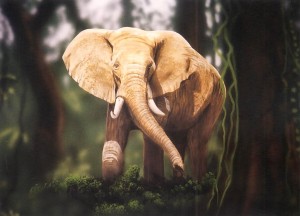 And elephants do have bad days. When a bull elephant goes through “must” he becomes a raging , unstoppable maniac that can destroy the average elephant enclosure. It’s a little like having a revved-up bulldozer supported by four pile drivers with an anaconda up front and a drunken baboon in the driver’s seat. The Denver Zoo recently created an elephant facility for such times, and it looks like it was designed with King Kong in mind.
And elephants do have bad days. When a bull elephant goes through “must” he becomes a raging , unstoppable maniac that can destroy the average elephant enclosure. It’s a little like having a revved-up bulldozer supported by four pile drivers with an anaconda up front and a drunken baboon in the driver’s seat. The Denver Zoo recently created an elephant facility for such times, and it looks like it was designed with King Kong in mind.
The most unfortunate elephant casualty I’ve heard about was reputedly at a German zoo. The keeper, it seems, was working at the back end of a terribly constipated pachyderm (now don’t laugh, okay?) when he finally succeeded in relieving the blockage. The resulting pressure upon release was sufficient to blow him over backward where he struck his head on something hard, died, and was buried under 200 pounds of elephant dung. (Did you laugh? Shame, shame!)
Apes
But of all the creatures I’ve come in contact with, there is one species that stands out in my estimation: the red ape, the orang utan, which means “forest person” in Malay.
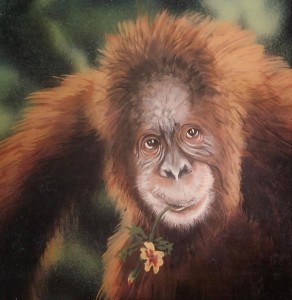 In my Mostly True Tale Primate Behavior, I’ve described the playful relationship I had for a short time with Sophia, an orang at the Brookfield Zoo, and her son, Kutai. About a decade ago I had a keeper at the Como Zoo primate house try to explain the personality difference between the great apes. He said that if you parked a car with a set of socket wrenches in the night-holding cages of chimps, gorillas and orangs, you’d see the difference when you came back in the morning. The chimps would have destroyed the car and clobbered each other with the wrenches. The gorillas would have slobbered the wrenches and be asleep on the car seats. The orangs would have disassembled the car and laid out the parts and the wrenches in a neat, orderly pattern. My experiences since then confirm this.
In my Mostly True Tale Primate Behavior, I’ve described the playful relationship I had for a short time with Sophia, an orang at the Brookfield Zoo, and her son, Kutai. About a decade ago I had a keeper at the Como Zoo primate house try to explain the personality difference between the great apes. He said that if you parked a car with a set of socket wrenches in the night-holding cages of chimps, gorillas and orangs, you’d see the difference when you came back in the morning. The chimps would have destroyed the car and clobbered each other with the wrenches. The gorillas would have slobbered the wrenches and be asleep on the car seats. The orangs would have disassembled the car and laid out the parts and the wrenches in a neat, orderly pattern. My experiences since then confirm this.
I’ve concluded that chimpanzees are cute when they’re young, but mature chimps are dangerous, hysterical, dirty animals. Gorillas can be just a little boring.
Orangs are infinitely fascinating. The patience and cleverness with which they plot escapes is legendary and almost unbelievable. When I went back to the Como Zoo recently to do murals for an expanded gorilla exhibit, I had to pass along the night-holding area of the orangs in the bowels of the primate building as well as to cross the steel mesh at the back of their exhibit space one floor up, on which I had painted murals long ago.
My new acquaintances on this job were a five-year-old male orang, Jaya (Malay for “victory” or “celebration”) and a 35-year-old female named Amanda (English for “Amanda”). Jaya was about the size of a human two-year-old, had wide brown eyes, a toothy grin, hands for feet at the end of short legs, and very long arms with narrow hands sporting chestnut brown fingernails. His mom, Markisa (“passion fruit”), 26, and his dad, Jambu (“mango”), 27, were in the same exhibit but not very interested in interaction.
When I passed the steel mesh at the back of the orang exhibit, Jaya would amble up to the mesh, climb up to my face level, hang with his hands way above his head and his feet up near the level of his armpits and plead for attention with his eyes. Soon Amanda would join him. When they saw that I was munching pretzels from a bag, they both extended their impressive lower lips through the mesh in an obvious request for a treat. Thereafter, I was marked in their minds as a sucker for a pitiful plea.
With their keeper, Megan, I learned that Jaya likes to have his belly scratched, likes to eat whatever your eating, and will spit, not very effectively, when frustrated by someone not acknowledging his cuteness. But if he goes to a water spigot to get a mouthful, you had best evacuate quickly. Often when Megan was scratching his belly he would hoist himself up a bit hoping that his penis would get equal attention.
“Yes, you have a wiener, we see that,” said Megan.
“And a fine wiener it is,” I said.
“He’s very proud of it,” she said.
He then began poking his one-inch erection through the mesh, demonstrating with his hips that sex ed for orangs begins early. Knowing what would come next, Megan suggested we step aside while Jaya produced an arc of urine across the hallway.
 Amanda was not a personality-free ape. The keepers referred to her as “the Princess.” She had a mirror in her night holdings cage. When she was on exhibit the keepers sometimes gave her a hairbrush. She would move up close to the glass so her public could see her better and proceed to comb her hair back, tossing her head like a Valley girl as if she had long, manageable tresses rather than stiff red stubble that hung over her eyebrows no matter how she brushed. She also got wigs and hats as treats.
Amanda was not a personality-free ape. The keepers referred to her as “the Princess.” She had a mirror in her night holdings cage. When she was on exhibit the keepers sometimes gave her a hairbrush. She would move up close to the glass so her public could see her better and proceed to comb her hair back, tossing her head like a Valley girl as if she had long, manageable tresses rather than stiff red stubble that hung over her eyebrows no matter how she brushed. She also got wigs and hats as treats.
I’ve only heard of one orangutan attack. A keeper went in to clean a night-holding area without making sure the two doors between him and the animals on exhibit were closed. It was the home of a mother orang with a young child. She came back into the enclosure, found the keeper there and bit him several times on the lower legs. He showed me the scars: they looked like human bites but much wider, with bigger individual teeth. Had his attacker been a gorilla or chimp (or maybe a human), he probably would’ve been killed or at least severely rearranged. While orangs, like other great apes, have astonishing strength, they seem to me to be very calm, quiet, almost contemplative creatures, and I can’t help feeling very benevolent toward them.
Crown of Creation?
They say it’s lonely at the top and I agree. As a human being, I am the crown of creation, the highest life form in the known universe, right?
Maybe not. When I’m with animals, huge ones, strange ones, ones with extraordinary capabilities, even just my house cat, I can have fleeting moments of seeing the world through their eyes, and it’s a welcome vacation from my own view. I no longer am alone at the top. I feel I’m part of an odd but grand, varietal, endlessly fascinating community of creatures. All of them would be totally out of place sitting at this laptop, but so would I be totally out of place in the blue ocean depths. Even in a submarine, I am totally inappropriate compared to the elegantly designed, highly intelligent whale. I would also be a complete failure as an elephant, a condor or a fruit bat.
The more I learn about animals, and the more I see that, like humans, they are each designed appropriately for their particular environment and role in the epic of life on earth and each have individual personalities, the closer I feel to them and the more I feel a humble gratitude to be one of this wide, diverse brotherhood of sentient beings.